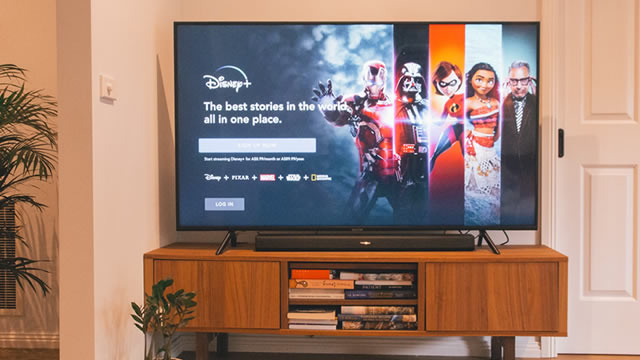Given the market’s bearish response to its fiscal first-quarter results, it would be easy to presume the worst of The Walt Disney Company (DIS -1.10%). To be fair, there are a few red flags buried in its Q1 numbers.
However, there’s more good news than not. Besides, most of these red flags’ underlying concerns are being addressed. Investors should be seeing the proverbial glass as half-full rather than half-empty, particularly in light of the stock’s subpar performance since its 2021 peak.
Translation: Disney stock is a buy here.
Don’t misread the message. Even the bulls have good reason to be asking tough questions here. Chief among them is what the media giant intends to do about its struggling cable and network television business.
By and large, though, most of the obvious questions have good answers.
Mixed bag
For the three-month stretch ending in December, Walt Disney turned $24.7 billion worth of revenue into a per-share profit of $1.76. Both were better than the year-ago comparisons of $23.5 billion and $1.22 per share. Both also rolled in above expectations of $24.67 billion and $1.45 per share.
The company did particularly well on the film front thanks to Moana 2, although its theme parks and hotels were a bright spot too. The real shining star of the quarter, however, is Disney’s direct-to-consumer (or DTC) streaming business, led by Disney+. Higher subscription prices pumped its top line up by 9% to nearly $6.1 billion, keeping this operation in the black.

Data source: Walt Disney. Chart by author. Numbers are in millions.
Not every Disney segment is on a tear, though. For instance, the linear (cable) television arm of its entertainment division suffered a 7% setback in sales. It’s still facing a cord-cutting movement driven by the advent of streaming services, including those offered by Disney.
Its sports business — mostly ESPN — is also currently less than impressive. While 8% year-over-year revenue growth paired with 15% growth is solid, this venture hasn’t shown any meaningful, sustained net growth since early 2022.
Perhaps the data nugget most troubling to investors, however, was the slight loss in its total number of streaming subscribers. Although Disney+ picked up a few more domestic customers, growth continues to slow here, while the service outright lost customers overseas. ESPN+ shed a few subscribers as well.

Data source: Walt Disney. Chart by author. Numbers are in millions.
The bears, of course, readily made a mountain out of that molehill.
Here’s the thing: Most (although not all) of these concerns are either being addressed, or will soon no longer matter.
Meet the new and improved Walt Disney
The Walt Disney Company is mostly operating in a holding pattern until it takes care of one huge matter of business. That’s the impending merger of all of Hulu with streaming-cable-television outfit FuboTV. Although Disney will be a 70% owner of this publicly traded company, it will be operated independently from Walt Disney itself, allowing the company to focus on more promising prospects like Disney+. It will also likely mean that Disney will stop reporting Hulu’s stagnating fiscal and subscriber metrics.
This strategic merger/divesting also paves the way for a stand-alone, sports-focused streaming service from Disney.
The planned sports-centric joint venture between Disney, Fox and Warner Bros. Discovery called Venu was unsurprisingly canceled just a few days after The Walt Disney Company announced its intentions for FuboTV in January. Fox supplies FuboTV with cable programming, potentially pitting it indirectly against its own partner, while Warner and FuboTV were contentiously unable to come to a carriage agreement in April of last year. However, that decision doesn’t necessarily prevent Disney from forging similar partnerships in the future. In the meantime, the launch of a stand-alone streaming version of ESPN is still slated to debut toward the end of this year.
This isn’t just a renamed ESPN+, which famously doesn’t include the programming offered via the cable channel. This is the streaming version of the live cable channel, plus plenty more exclusive on-demand content.
It matters simply because live sports is still the single biggest reason people are willing to pay sky-high cable bills, according to a recent survey from CableTV.com.
But won’t this hurt the cable television business, including Walt Disney’s linear TV arm (consisting of The Disney Channel and the ABC network)? It certainly won’t help. However, there may be little help on the horizon for cable anyway. Given that linear television only accounts for about one-tenth of Disney’s revenue and roughly 20% of the company’s operating income, focusing fewer resources on its TV business to put more on its most promising growth prospects — like theme parks, films, and streaming — is arguably the more fruitful long-term move.
Buckle up
It’s admittedly a lot to take in. And, given Disney’s lackluster and somewhat inconsistent performance since 2020, many investors are understandably not interested in digging into the company’s current evolution.
The thing is, these are the growth-minded moves the market’s been waiting on for a while. The Walt Disney Company’s foreseeable future is more promising now than it’s been since before the COVID-19 pandemic took hold, even if most people don’t seem to see it yet.
Just bear in mind that this ticker’s still got plenty of potential volatility left to dish out. It could take months for investors to start seeing — and then believing in — the improvement being made here. While it’s worth the wait, it could be an occasionally uncomfortable one.
Financial Market Newsflash
No financial news published today. Check back later.










